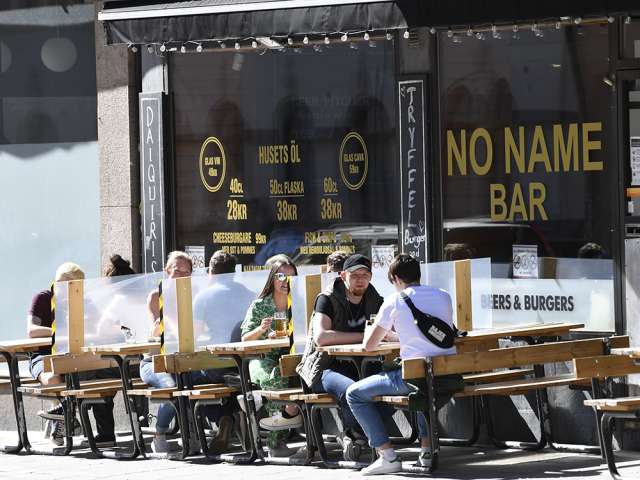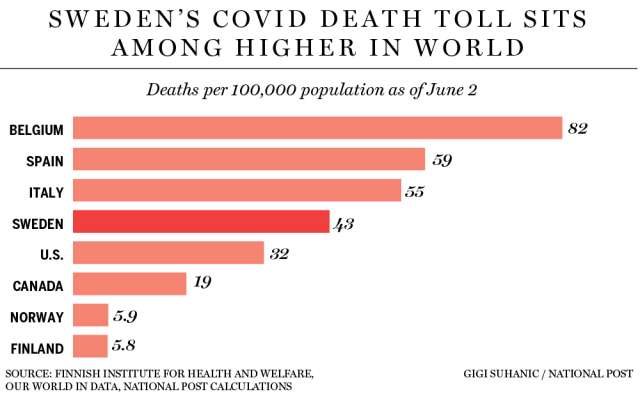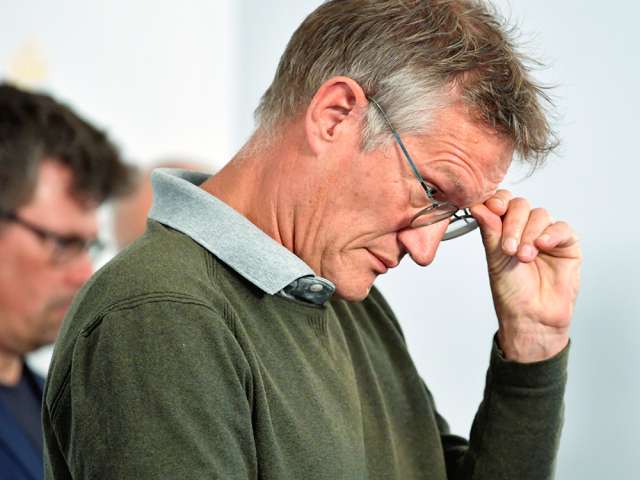Sweden could have gone the same route and acheive the same outcome as Finland and Norway. And there's the but...Gurney: Sweden took a gamble on COVID. And it lost the bet badly
Matt Gurney
Published:June 3, 2020
Updated:June 4, 2020 6:02 AM PDT
The country's lax policies resulted in a death rate amongst the highest in the world, only 'marginal' economic benefits and no herd immunity
The Swedish model failed.
The Swedish model, in this context, refers to Sweden’s approach to managing the COVID-19 pandemic. Compared with other Western nations, Sweden’s policies were relatively more lax. There were still some restrictions — Sweden did restrict large gatherings and close some schools, and those who could work from home were advised to do so. But much of life in Sweden carried on as normal. No hard lockdowns, no sweeping isolations. Schools for children under 16 remained open. So did restaurants and bars. This was a calculated decision, strongly advocated by the country’s top epidemiologist, Anders Tegnell. Tegnell became, perhaps unfairly, something of a poster boy for the many lockdown skeptics across the free world, who argued that Sweden’s policies were a better balance between preserving the economy and saving lives.
The problem is, it didn’t work, and even Tegnell now admits that.
The Swedish model always had a certain cold, logical appeal to it. In theory, Sweden could have absorbed somewhat higher initial deaths, in exchange for more rapid development of herd immunity and a preserved economy. It has been fashionable of late to casually dismiss any concern about the economy as some crass capitalist valuation of dollars over lives. That’s nonsense. The economy is life — the quality of life, certainly, but also literally life. Our complex civilizations are sustained only by fantastically complicated interconnected supply chains that keep critical utilities and supply chains operating. Without those, a case of COVID might soon be the least of our worries. The economy matters, and again, it was always clear what Sweden was trying to do — take a blow, withstand it, and get back to normal.
 People enjoy the sunny weather at an outdoor restaurant in Stockholm on May 30, 2020. Henrik Montgomery/TT News Agency/AFP via Getty Images
People enjoy the sunny weather at an outdoor restaurant in Stockholm on May 30, 2020. Henrik Montgomery/TT News Agency/AFP via Getty ImagesIt was a gutsy strategy, to be blunt — and if you are wondering just how gutsy, consider that Sweden was the only advanced Western democracy to give it a whirl. But guts don’t override facts. The strategy was not successful.
Sweden’s death rate exceeds, considerably, that of its immediate peers — the other Nordic countries. Sweden has seen 450 deaths per million (just over 4,500 actual deaths). The comparable deaths-per-million figures for its neighbours are 100 for Denmark, 58 for Finland and 44 — one-tenth Sweden’s figure! — for Norway. (Canada’s 7,400-some-odd deaths, for those wondering, works out to just under 200 per million — far better than Sweden but nothing to write home about.) Overall, Sweden’s deaths-per-million figure is one of the worst in the world, ahead of hard-hit France (443), though considerably behind the U.K. (585), Spain (580) and Italy (555).
Sweden’s numbers, therefore, are obviously bad, though not the worst. But the death rate is just part of Sweden’s calculus. If Sweden had taken the heavy blow and achieved herd immunity or preserved its economy, you could argue — grimly, but fairly — that the strategy had worked.

But it didn’t. Sweden’s economic numbers aren’t the worst in Europe, but they also aren’t markedly better (a Swedish economist recently noted that any economic benefit to Sweden’s COVID strategy was proving to be “marginal.”) Setting aside comparisons, the country’s economy is objectively suffering, as are economies all over the world — economic activity has cratered in Sweden, with a GDP drop of seven per cent projected — again, in line with what we’re looking at elsewhere.
Meanwhile, the hoped-for herd immunity also didn’t materialize. Though epidemiological experts will cite varying figures for how much of a population must survive exposure to the virus to achieve herd immunity — the point at which the virus struggles to find enough vulnerable human hosts to continue spreading — the low-end figure is somewhere around 60 per cent, with many experts believing the true figure is much higher. Swedish officials had been saying as recently as a few weeks ago that herd immunity in hard-hit Stockholm, at least, was a matter of weeks away. In fact, blood testing of Stockholm residents showed that by the end of April, 7.3 per cent of the population had acquired some degree of immunity. Tegnell admitted in an interview late last month that he was surprised how low that figure was, and estimated that Stockholm’s true figure might now be above 20 per cent. It might be! But that’s still wildly off the minimum threshold of 60. The herd immunity strategy has proven a bust.
 Top Swedish epidemiologist Adners Tegnell, seen at a news conference on June 3, 2020, says that if he knew before what he knows now, he would have taken a different approach to handling the pandemic. Andres Wiklund/TT News Agency
Top Swedish epidemiologist Adners Tegnell, seen at a news conference on June 3, 2020, says that if he knew before what he knows now, he would have taken a different approach to handling the pandemic. Andres Wiklund/TT News AgencyTegnell now accepts this, and says that if he knew before what he knows now, he would have taken a different approach — somewhere between what Sweden did and what the rest of the world did. That’s probably fair. As we learn more about COVID, there’s little doubt that we’ll discover that other jurisdictions overreacted in some ways — imposing economic or social restrictions that weren’t necessary, or keeping them in place longer than needed. No country hard hit by COVID-19 will have performed perfectly. We’d all likely have been better off aiming for that undefined middle ground Tegnell referred to.
Granted. But the facts are clear: confronted by a novel viral threat, most of the world locked down hard, to preserve health-care systems and buy time to study the virus and its effect on humans. Sweden chose a far more liberal course, and paid for it in lives relative to their peers, but did not escape the economic consequences or achieve herd immunity. By any metric, this is a failure. Sweden stoically took the pain, but realized no gain.
Related link: Gurney: Sweden took a gamble on COVID. And it lost the bet badly